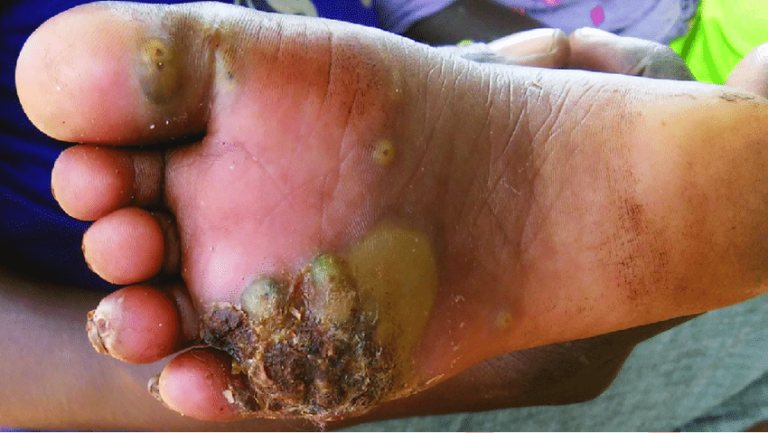Health workers in Uganda have reported a significant decline in jigger infestations in the Busoga region, an area previously known for its high prevalence.
They attribute this improvement to extensive community education and targeted intervention programs that have significantly raised awareness and encouraged proactive prevention measures.
Sole Hope, a non-governmental organization (NGO) working alongside Uganda’s Ministry of Health to combat jigger infestations, revealed that the burden in Busoga has dropped by more than half, marking a notable public health victory.
“When we look at our in-house statistics, the number of cases we used to treat compared to now shows an 80 percent reduction,” said Enock Kwagala, head of the medical department at Sole Hope. “We attribute this decline to health education, community sensitization, and local involvement in treatment and eradication efforts.”
Despite this success, health officials are raising concerns about the Bugisu region, located to the east of Busoga, which is now emerging as a new hotspot for jigger infestations.
“Jigger infestation is classified as a Neglected Tropical Disease (NTD), and while many associate it with Busoga, we are now seeing a significant burden in Bugisu,” Kwagala noted. He emphasized that intervention efforts are already underway to curb the spread in the region.
Sole Hope, in collaboration with the Ministry of Health’s Vector Control Division, has expanded its outreach and currently provides services through multiple health facilities in affected areas.
“We work with six facilities in the Bugisu region and operate an inpatient treatment center in Jinja,” Kwagala explained.
“Each facility handles around 90 patients per month, while our Jinja center treats approximately 60 patients weekly.”
Kwagala made these remarks on Thursday during an event marking World Neglected Tropical Diseases Day in Busabala, Wakiso District, an area grappling with high rates of bilharzia, another NTD that continues to pose a serious public health challenge.
During the event, Dr. Daniel Kyabayinze, Uganda’s director of public health, highlighted the country’s significant progress in eliminating several NTDs.
“There has been no reported case of guinea worm in Uganda since 2003, and in 2009, the country was officially declared guinea worm-free,” Kyabayinze said, emphasizing Uganda’s success in combating certain parasitic diseases.
Dr. Alfred Mubangizi, Uganda’s NTD program manager, pointed to the elimination of river blindness as another milestone achievement.
The disease, which previously caused severe sight loss in parts of the country, has now been eradicated nationwide.
“We have now eliminated river blindness and stopped treatment, except in five districts near South Sudan—Kitgum, Lamwo, Adjumani, Moyo, and Amuru—because black flies from South Sudan could potentially reintroduce the disease,” Mubangizi explained.
Despite these advances, health officials remain concerned about bilharzia, which is transmitted through freshwater snails and remains widespread, particularly in fishing communities where water contact is inevitable.
“Bilharzia is still a major public health concern in Uganda, including here in Wakiso,” Mubangizi warned.
“The challenge is that it spreads through water contact, and it is impossible to prevent people, especially those in fishing communities, from coming into contact with water.”
With continuous intervention efforts and health awareness programs, authorities remain hopeful that Uganda will further reduce the burden of NTDs and improve the overall well-being of affected communities.

